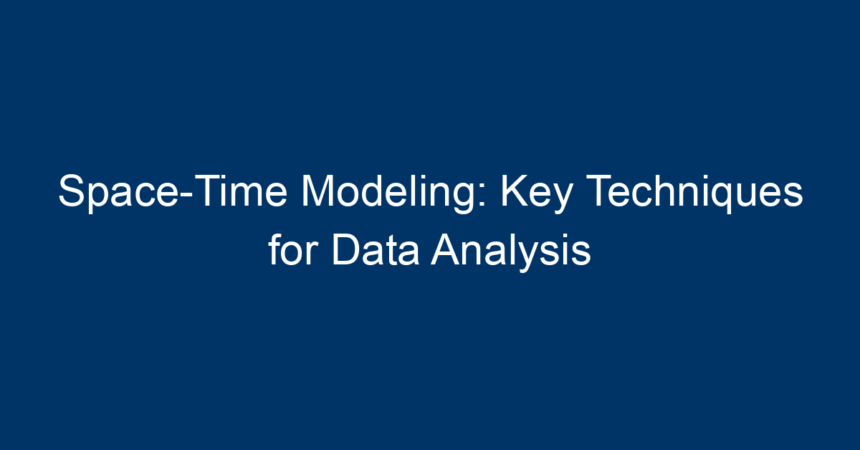In today’s data-driven world, analyzing complex data sets requires innovative approaches that can capture both spatial and temporal dimensions. Space-time modeling is an essential framework that integrates these two aspects to provide a comprehensive understanding of data trends and patterns. By analyzing how data points fluctuate over time and across different geographical locations, researchers and analysts can derive actionable insights that unfold new opportunities in various fields, from urban planning to environmental monitoring and beyond.
In this article, we will explore key techniques in space-time modeling, delve into their applications, and provide practical insights for data analysts looking to harness this powerful methodology.
What is Space-Time Modeling?
Understanding the Basics
At its core, space-time modeling is a statistical technique that blends spatial data (such as geographical location) with temporal data (such as time series). This fusion enables analysts to observe and interpret how variables may change across both dimensions. The goal is to create models that reflect the underlying relationships between space and time, allowing for more accurate predictions and analyses.
Importance of Space-Time Modeling
The importance of space-time modeling lies in its ability to process vast amounts of data that would be infeasible to analyze separately. By taking advantage of the interplay between time and space, analysts can identify trends, forecast future events, and uncover latent relationships that provide critical insights into phenomena such as climate change, consumer behavior, and epidemiology.
Key Techniques in Space-Time Modeling
1. Geostatistics
Geostatistics refers to statistical methods used to analyze spatially correlated data. Techniques in this area include variogram analysis and kriging, which allow for the estimation of unknown values based on known data points. These methods are essential in applications such as environmental monitoring, where researchers want to predict pollution levels across different locations and times.
-
Variogram Analysis: This technique quantifies spatial correlation by measuring how data varies over distance. By analyzing the variogram, analysts can derive critical insights into the structure of spatial data.
- Kriging: A powerful interpolation method that estimates values at unmeasured locations through weighted averages of surrounding points. Kriging not only provides estimates but also quantifies the uncertainty associated with those estimates.
2. Time Series Analysis
Time series analysis is a foundational approach in space-time modeling that focuses on data points collected or recorded over time. The techniques used include autoregressive integrated moving average (ARIMA) models, seasonal decomposition, and exponential smoothing. These techniques can help analysts understand trends and seasonality in data.
-
ARIMA Models: This popular method identifies patterns in temporal data, offering valuable foresight into future values. Analysts might use ARIMA to forecast sales, climate conditions, or disease outbreaks.
- Seasonal Decomposition: Breaking down a time series into trend, seasonal, and residual components allows researchers to isolate and understand specific influences on the data.
3. Spatial-Temporal Point Process Models
These models are particularly useful for analyzing events that occur at specific locations and times (e.g., crime incidents, earthquakes). Techniques include the Hawkes process and log-Gaussian Cox processes, which excel in depicting the interaction between events in both space and time.
-
Hawkes Process: A self-exciting point process that models how past events influence future occurrences. This is particularly useful in fields like criminology, where past crimes may increase the likelihood of future incidents in the same area.
- Log-Gaussian Cox Process: A more flexible model that allows for varying intensity across space and time. This is beneficial for studying phenomena where events cluster more strongly in certain areas or during specific time frames.
4. Machine Learning Techniques
The advent of machine learning has revolutionized space-time modeling. Algorithms like recurrent neural networks (RNNs) and spatial-temporal convolutional networks can process vast volumes of data, capturing intricate patterns that traditional methods might miss.
-
RNNs: Particularly well-suited for time series forecasting, as they maintain a ‘memory’ of previous inputs. This capability allows for better predictions based on historical data.
- Spatial-Temporal Convolutional Networks: These networks efficiently analyze spatial and temporal data in tandem, making them ideal for tasks such as traffic prediction or environmental monitoring.
Practical Applications of Space-Time Modeling
- Urban Planning and Management
Space-time modeling helps urban planners make informed decisions regarding infrastructure development and resource allocation. By analyzing how populations move and interact across space and time, planners can optimize services and identify areas needing intervention.
- Environmental Monitoring
In environmental science, space-time models track pollution levels, species migration, and climate change effects. Understanding the spatial and temporal patterns of these phenomena allows for proactive measures in conservation and resource management.
- Epidemiology
During health crises, such as the COVID-19 pandemic, space-time modeling has been vital in tracking disease spread and assessing intervention effectiveness. By integrating geographical and temporal data, public health officials can better allocate resources and implement strategies.
- Marketing and Business Analytics
Businesses can utilize space-time modeling to optimize marketing outreach and customer engagement. Analyzing consumer behavior trends across different regions and times helps businesses tailor their strategies effectively.
Challenges in Space-Time Modeling
While space-time modeling offers tremendous opportunities, it is not without challenges.
Data Quality and Availability
Incomplete or low-quality data can significantly hinder analyses. Analysts must ensure reliable data sources and optimal data cleansing techniques to maximize the effectiveness of their models.
Computational Complexity
Analyzing large datasets with complex models requires substantial computational power. Organizations may need to invest in high-performance computing resources to effectively process and analyze their data.
Model Selection
Choosing the right model for a specific application is critical. Analysts must understand the underlying assumptions of different techniques to select the most appropriate method for their data and objectives.
Conclusion: Actionable Insights for Data Analysts
To harness the power of space-time modeling, data analysts should:
-
Invest in Training: Learn and master various techniques to become adept at applying space-time modeling in relevant scenarios.
-
Utilize Quality Data: Prioritize data quality and ensure robust data collection methods for reliable analyses.
-
Experiment with Different Models: Explore multiple models to determine which best fits the specific context and objectives of the analysis.
- Stay Current with Technology: Keep abreast of emerging technologies and methodologies, particularly in machine learning, to enhance modeling capabilities.
By following these actionable insights, data analysts can enhance their skills, provide valuable insights, and contribute significantly to their organizations’ data-driven decision-making processes. Space-time modeling is not just a technique; it is a gateway to understanding the complexities of our world, offering clarity in the midst of chaos.




